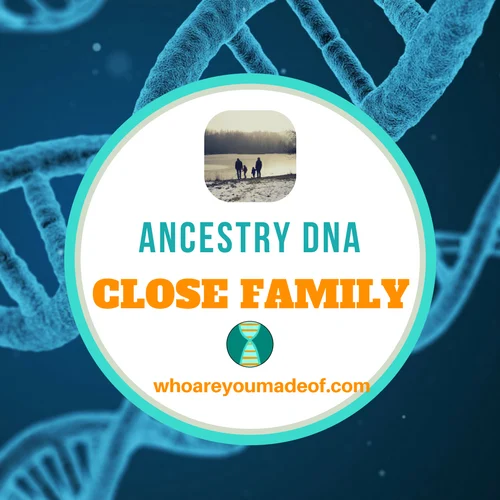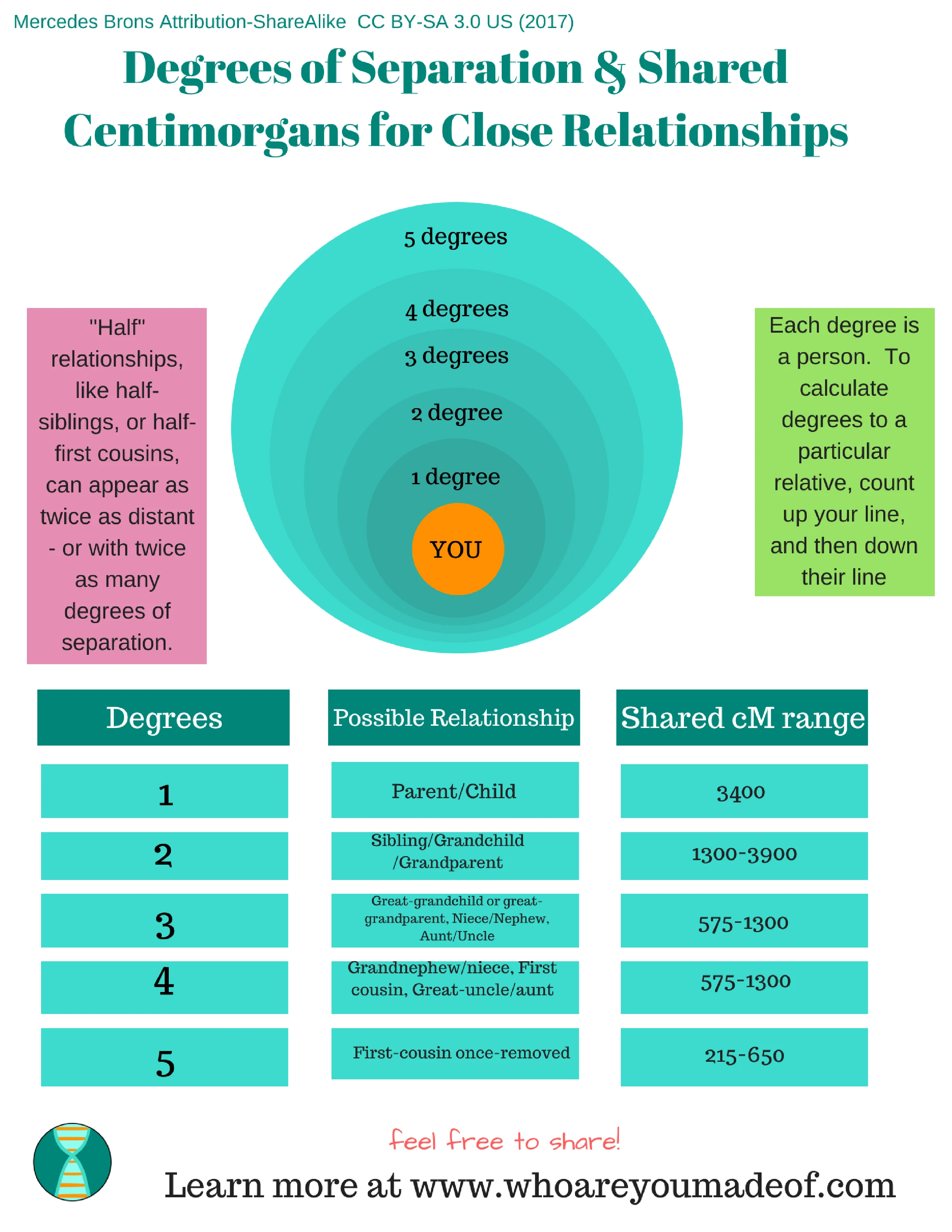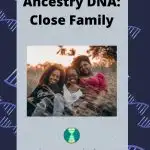Have a Close Family match on Ancestry DNA? Who is this person? How are they related to you? Is there a way it could be a mistake?
I'm going to answer all of these questions, and more, in this post.
Getting a new Close Family DNA match on Ancestry can be exciting and confusing. For some people, it is a cause for anxiety.
By the end of this article, you will have a much better understanding of what it means to have a match show up in the Close Family category. In addition, you'll be able to make a decision about what to do next.

How is a Close Family match related on Ancestry DNA
DNA testing companies use the amount of shared DNA that you have with someone in order to determine the approximate relationship. There is a range of amount of DNA typically shared between all relationship types, and most of the time, these ranges overlap.
In this case of the Close Family category, a person who is your DNA match and falls into this category has one of the following relationships to you:
- aunt
- uncle
- niece (1301-2193
- nephew
- grandparent
- grandchild
- half-sibling (1320-2134)
- double-first cousin
- first cousin (very unlikely, but possible)
What if I don't know my Ancestry DNA close family match?
If you know, or thought you knew, all of your close biological family, and you just did the test out of curiosity, perhaps looking for your ethnicity estimate, you might be surprised to see a DNA match show up as a close family match to you.
When a test taker sees a close match that they don't know, the initial response is often skepticism. Maybe the results are wrong?
While laboratory errors are possible, and they do occasionally happen, they are exceedingly rare. It is much, much more probable that the person who you see as your DNA match falls into one of those relationships that I mentioned above.
How do I figure out how a Close Family match on Ancestry DNA is related to me?
Since people who fall into the Close Family category on Ancestry DNA can be related to the test taker in a few different ways, you have to be creative and use a combination of common sense and traditional genealogical research in order to figure out the most likely relationship.
I'll give you some ideas here on what to look for.
Centimorgans can help you figure out how you are related to your close family match
Centi-what? Centimorgans is just a unit of measure for defining the length of DNA segments. (Read this article to find out how to see your shared centimorgans on Ancestry.)
For each potential relationship level, there are generally accepted ranges of shared centimorgans. This may help you exclude a particular relationship, though there will still be some overlap and you'll have to use more of these tips to get a better idea of who the match is to you.

Do you have any Shared Matches with this Close Family match?
This is a great way to figure out which side of your family your mystery match is on. If you are new to your search for family, and you don't know much about your biological family, this is also a great way to "group" your matches into family lines.
A Close Family match will share many matches with you, and so you can safely assume that the closest of those shared matches are on the same side of your family tree.
If you know something, or know a lot, about your family tree, and you have shared matches with your Close Family match, this will be able to tell you a lot about your relationship.
When I first did my DNA test years ago, my top match was an unknown person to me. My second top match was my dad's first cousin (making me certain that my father was my father).
In order to figure out who my mystery match was, I had more people from different lines of my family do the DNA test.
Eventually, based on shared matches, I was able to determine with 100% certainty exactly which group of siblings my match descended from.
Can you figure out how old your close family match is in relation to the test taker?
If you can determine the approximate age of your DNA match, this can sometimes help you eliminate a few possibilities. For example, if the mystery DNA match is about 20 years older than you, then obviously they cannot be a grandparent or a grandchild to you.
Check out the geographical area where your close family match's close ancestors were born
When I write "close ancestors", I mean parents and grandparents. If you have relatives in common with them (instead of them with you), then the parents and grandparents are the only people who you might share in common.
So, look to see if you can find out the city and state of where they lived, and where they were born. This can give you some clues.
In my own family, I had a first cousin match come up suddenly. We were able to figure out that since she was born in a particular town, and I had an uncle who had lived in that particular town his whole adult life, that he was likely her biological father.
A paternity test later proved that he was. Mystery solved and our family is happy to have a new cousin.
Have you tried to make contact with your close family match on Ancestry?
Depending on who the match is, their particular family background, and their motivations for taking a DNA test, you might be able to make contact with your match and learn something from them about how you might be related.
Your match might be able to tell you whether they are adopted, or are looking for a half-sibling because their parent mentioned that they had one, or never knew their biological family.
Or maybe you are the one looking, and they have a great family tree already built and you can use that information to find out who your parents or grandparents are.
But...
What to do before you contact your Close Family match on Ancestry
Because of the nature of your close relationship with this DNA match, and because (depending on who you are in this situation) sometimes an unexpected Close Family match can sometimes (but not always) be the result of an event that people might have been trying to keep a secret, you should be careful when considering making contact.
Tips for contacting Close Family matches on Ancestry DNA
Make sure you take screenshots of their family tree, if they have one, as soon as you can. While most people won't intentionally try to hide information, some people do and have done this.
Most likely, their family tree is your family tree, and this information can be very helpful to you.
Carefully craft your message to your DNA mtch
Be cautious when writing your message. Be specific, yet not too specific. For example, if you are adopted and only know information about one line of your family, you can say something like this - if they have no family tree online that you can find:
"Hi, I am wondering how we might be related. In my family, I have Smiths and Browns from Connecticut. What are the surnames in your tree? I am looking forward to hearing back from you."
Don't imply that your DNA match's family tree is "wrong"
If they have a family tree posted, and none of the surnames match what you were expecting, you can still write a message:
"Hello, I saw on Ancestry that we are a Close Family match. I have Smiths and Browns from Connecticut, and I see that your family is from Connecticut, too. I'd love to exchange messages to see if we can find the connection."
This way, you aren't implying that either of your family trees are "wrong", per se, but you are drawing attention to yourself as a match. They might do some research about the possible relationship categories, and come to some conclusions on their own - and maybe help you out in the process.
Don't reveal too much information in your first message
While I recommend being honest with your DNA matches, if you are adopted, I don't think you necessarily have to mention that in your first message. You could say something like "I don't know much about my family history, and am trying to learn more."
If they respond and seem friendly and helpful, you can then let them know that you are adopted (if you want to).
Read more about contacting your DNA matches in my post about whether you should contact your DNA matches or how to contact DNA matches.
Special instructions for adoptees or those searching for a biological parent before contacting DNA matches
Sometimes people are surprised that their DNA test can lead to the discovery of previously unknown family members. While this is understandable, this does not excuse rude or unfriendly behavior - we are all family and should treat each other with respect.
I always caution adoptees and those who are searching for a biological parent to proceed with contacting DNA relatives carefully. Those of us who do know who our biological parents and grandparents are can do our part in welcoming new family members by being kind, welcoming, and willing to share information.
Conclusion
I hope that this post has helped you understand a little bit more about your Close Family match, and that you have excellent luck in figuring out exactly who they are to you. If you have any questions about your match, please feel free to leave a comment here and I'll see if I can help.
To get the most from your family tree search, or your family search, you might want to consider getting a subscription to Ancestry to help you build you tree as you learn more about your family. You can get a free trial here by clicking this link (though I will receive a small commission at no cost to you if you do end up purchasing): Ancestry Free Trial
Thanks for stopping by!



J. t.
Thursday 28th of December 2023
Hi, I have matched with someone as close family (27% shared DNA, 1875 cm across 44 segments) I was contacted by my supposedly 2nd cousin that shared a match with both of us. She was wanting to know how we were related. Once I told her I didn't know and any help she could give me would be appreciated, she stopped correspondence. I've spoken to my mother and father and neither know this person or the family last name. I've tried to contact the person that I share the 27% DNA as well but they haven't answered back. Could this be a half sibling? If the match is an uncle then is it safe to say my dad isn't my dad?
Trish
Monday 21st of June 2021
My aunt came up as close family 1st cousin…..why did she not come up as my aunt?
Cyndie Bryant
Wednesday 16th of September 2020
Shared DNA: 1,712 cM across 34 segments Longest segment: 141 cM
I was adopted and I am wondering if this is a newphew or hald sibling?
Cheryl stockford
Saturday 28th of March 2020
Hi, I have been contacted by someone on ancestry who reports as a close relative sharing 2048 cm across 69 segments. This leaves us assuming we are half siblings. 1) is this a safe assumption and 2) how do I determine if we share a father, whether it’s his father or the one I knew as mine? Coincidentally, I have also had a dna match reported (600cm) with someone who has my fathers last name. I’m not understanding how both of these events can be happening if the dna results are correct?
Mercedes
Tuesday 31st of March 2020
Hi Cheryl, Thank you so much for your comment and questions. A match at 2048 could certainly be a half-sibling. Your question left me with the assumption that you are considering that this could be a half-sibling on your mother's side, as well? This would explain why you have a DNA match with your father's last name, assuming the DNA match with your father's surname is a relatively close match. Alternatively, you could check your "shared matches" or "matches in common" that you have with this match to see if the relative from your father's side also matches this person (this only works with close matches, not distant cousins). There is one thing that you can do to figure out if this DNA match, assuming they are a half-sibling, is a half sibling on your mother or father's side. If you upload your DNA to Gedmatch and you can get your match to do the same, you can use the X DNA One-to-One comparison tool to compare your X chromosomes. Since males don't inherit X DNA from their fathers and females do, if this DNA match is a half-sibling from your father's side, you will share no X DNA. If you share large segments of X DNA, you can assume that you inherited them from your common mother. HOWEVER, it is important to consider that a DNA match of 2048 could be related to you in a few other ways. For example, this person could be a FULL aunt, or FULL uncle, as well as a FULL nephew or FULL niece. You might be able to rule some of these options out based on their age, and maybe you already have. Here are a few links that might help you: https://dnapainter.com/tools/sharedcmv4 https://genetics.thetech.org/ask-a-geneticist/shared-dad-or-mom-half-siblings